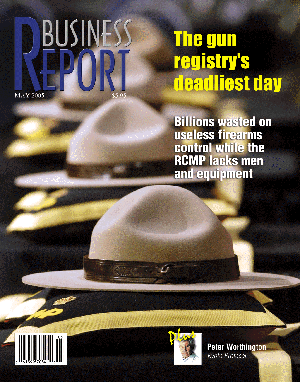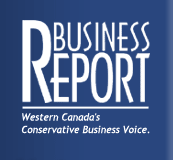
 by Shafer Parker
by Shafer Parker
Billions wasted on useless firearms control while the
RCMP lacks men and equipment
March 3, 2005, will be remembered by law- enforcement historians
for several reasons, most of them tragic. On that day, four
RCMP officers, Constables Peter Christopher Schiemann, 25,
Anthony Fitzgerald Orion Gordon, 28, Lionide Nicholas Johnston,
32, and Brock Warren Myrol, 29, were shot to death by James
Roszko, 46, as they investigated a marijuana-growing operation
on his farm near Mayerthorpe, Alta, some 130 kilometres northwest
of Edmonton. It was also the first time since 1911 that so
many RCMP officers had died in one operation, and it was the
first time in 20 years that multiple Canadian police officers
had been killed together.
But the Mayerthorpe tragedy may also come to be remembered
as the straw that broke the $2-billion federal firearms program
(when enforcement costs, compliance costs and economic costs
are added in). From its original inception, the program was
designed to, among other things, "provide police with
important information to help prevent injuries and investigate
firearm-related crimes," as stated by Public Safety Minister
Anne McLellan last May. But it did nothing to protect the
four young officers who were gunned down at about 10 a.m.
on that chilly March morning. In fact, according to RCMP Corporal
Wayne Oakes, beyond wearing standard bulletproof vests, the
officers were not even taking any extra precautions, as they
had no reason to believe they were in imminent danger. This,
despite Roszko's being under a court-ordered weapons ban since
2000, and in spite of his publicly stated hatred for police
and his known possession of several high-powered rifles.
Conservative MP Garry Breitkreuz points out that the registry
is essentially useless in protecting police in such situations
for many reasons, including the following:
* The government does not require that the 176,000 persons
prohibited from owning firearms report any change of address
to police.
* Police do not track the 37,000 persons with restraining
orders against them, or the 12,000 gun owners who have had
their firearms licences refused or revoked.
* The law does not require gun owners to store their registered
firearms at their home addresses or tell the government where
they are stored.
* The government does not keep track of registered firearms
that are loaned between licenced firearms owners.
* As of last August, more than 315,000 handgun owners had
failed to re-register more than 600,000 handguns.
* Somewhere between 400,000 and one million gun owners have
failed or refused to obtain a firearms licence, meaning their
guns remain unregistered.
* According to Statistics Canada firearm import and export
records, the government still has more than 10 million guns
to register.
* Finally, gun-registration certificates contain too few
identifying characteristics, making it almost impossible to
verify that any particular gun is registered in the system.
Even worse, a very real possibility exists that over the
past 10 years the gun registry's prohibitive costs (including
another $97 million budgeted for 2005-06) had depleted RCMP
resources to the point that a Roszko-type disaster became
inevitable. That no senior officers or emergency-response
teams were on the scene at the Mayerthorpe farm was no surprise.
Such ranking officers are too few and stretched too thin.
Chronic funding shortages have led to a change in RCMP policy
in which the force deliberately seeks new recruits with life-
and job-related experience who supposedly require less supervision.
Rural detachments are particularly hard hit. In 2004, Alberta
had the third-lowest proportion of police officers, with 160
per 100,000 residents. Only Newfoundland and Prince Edward
Island had a lower ratio.
"The Liberal gun-registry fiasco is much bigger than
the Quebec Sponsorship Scandal," Breitkreuz says. "Don't
take my word for it. The auditor general has verified that
any value Canadians receive in terms of enhanced safety is
minuscule compared to the amount of money being spent."
Breitkreuz reports that RCMP officers told him that Roszko
almost certainly monitored police radio transmissions, enabling
him to know where the officers were as he sneaked back onto
his farm to do his deadly business. Encrypted communications
devices are available that would have made third-party monitoring
impossible, but the RCMP cannot afford them. "The gun
registry didn't keep guns out of [Roszko's] hands," Breitkreuz
says, "but the money spent on it could have provided
a tool that would have prevented him knowing where police
were, and possibly saved lives."
The basic problem with Canada's Firearms Act, says Dave Tomlinson,
president of the National Firearms Association, is that the
people who wrote it were not competent in systems design.
Unfamiliar with regulatory law, they gave little thought to
how each clause affects all the other parts.
Tomlinson points out that the act's problems are exacerbated
by the federal government's intrusion into a provincial area
of responsibility. "Firearms control is basically regulatory
law," he says. "But regulatory law is a provincial
area, so they had to put their law into the Criminal Code."
But because the Firearms Act is criminal law, criminal rules
apply, which means that criminal intent, or mens rea, must
be established in order to convict someone of an offence.
On the other hand, firearms control is inherently regulatory
and administrative two types of law essentially incompatible
with the Criminal Code. "All this is very confusing,"
Tomlinson says. "It's no wonder police repeatedly screw
up when they try to lay criminal charges under the Act."
Not surprisingly, because the Firearms Act is a schizophrenic
attempt to combine criminal law and regulatory elements into
an administrative framework within the Criminal Code, the
result is a hodgepodge of draconian penalties and gargantuan
loopholes that allow gun owners to pull such mischief as legally
registering their guns at multiple addresses ("Up to
20 if the guy is smart enough," says Tomlinson), and
even legally buy and carry a concealed handgun without licence
or certificate. (A calibre-455 Webley Mark II handgun, for
instance, is classed as an antique and therefore under none
of the rules and regulations of the Act.)
Nevertheless, Canada's Liberal government remains committed
to its registry, to the point of making claims for it that
are at best unverifiable. In an e-mail to MPs last December,
the Honourable Roy Cullen, parliamentary secretary to the
minister of public safety, claimed, for instance, that "important
client and public safety results [are] being achieved."
"How can that be," asks Breitkreuz, "when strict
logic declares that laying a piece of paper beside a gun will
never stop someone from pulling the trigger?" He also
notes that gun-registry "clients" are not really
being "served"; they participate under threat of
severe criminal penalties of up to 10 years in jail for failing
to register.
In response to Liberal boasts that a January 2003 Environics
survey found that 74 percent of Canadians support the current
gun-control legislation, Breitkreuz counters that a national
survey by JMCK Polling in April 2004 showed that a substantial
majority of Canadians (76.6 percent) agreed that the registry
should be scrapped if the money were devoted to other law-enforcement
priorities. And as to claims that the federal program is much
more than a gun registry because it also comprises safe storage,
handling and transportation of firearms, safety training and
education and effective border controls, Breitkreuz points
out that all these things existed before the registry was
established the difference being that the whole safety and
handgun-registration system then cost the government about
$10 million per year, much less than the nearly $100 million
now being spent annually.
Cullen claimed that registering about two million firearms
licence holders and almost seven million firearms is "a
true success story in just over five years." In fact,
the gun-registry law, Bill C-68, was passed in 1995, nearly
10 years ago. Yet today, more than 400,000 firearms owners
are still unlicenced and, by the government's own count, more
than eight million guns remain unregistered, forcing Anne
McLellan to admit to Parliament that even the government could
not claim the registry will be fully implemented until December
31, 2007.
Moreover, many reputable independent observers deny Canada's
gun registry has led to any meaningful increase in public
safety. Within the past year, police chiefs such as Julian
Fantino of Toronto and Jack Beaton of Calgary have publicly
stated the registry has not helped solve or prevent a single
crime, but that it has frequently provided police with inaccurate
information. Instead, the chiefs said, the wave of gun crime
they are currently fighting stems from criminally owned, never-registered
guns.
Even government agencies disavow the registry's effectiveness.
According to an official statement by Statistics Canada, "The
specific impact of the firearms program or the firearms registry
cannot be isolated from other factors." Instead, Statscan
reported last July that in 2003 the robbery rate increased
(+5 percent) for the first time since 1996; meanwhile, robberies
committed with a firearm increased by 10 percent.
Ironically, an increase in gun crime may actually lead to
a corresponding increase in public safety. The Canadian Centre
for Justice Statistics reports that 48 percent of assaults
involving firearms result in the victims being injured, compared
to a 53 percent injury rate when knives are involved and a
76 percent injury rate when clubs are used. The same is true
for armed robberies, where 12 percent result in injury when
firearms are used, 17 percent when knives are employed, and
47 percent lead to injuries when the weapon is a club.
So if firearms control is such a monumental failure, why
do the federal Liberals defend it? "It's purely political,"
says Breitkreuz. "I've never discovered any other reason.
They don't care how much it costs so long as it caters to
voters in Quebec, Ottawa, Toronto and Vancouver. Oh, and they
love to be thought of as being on the cutting edge of societal
development at the United Nations."
All content ©Copyright 2005 Business Report.
|

